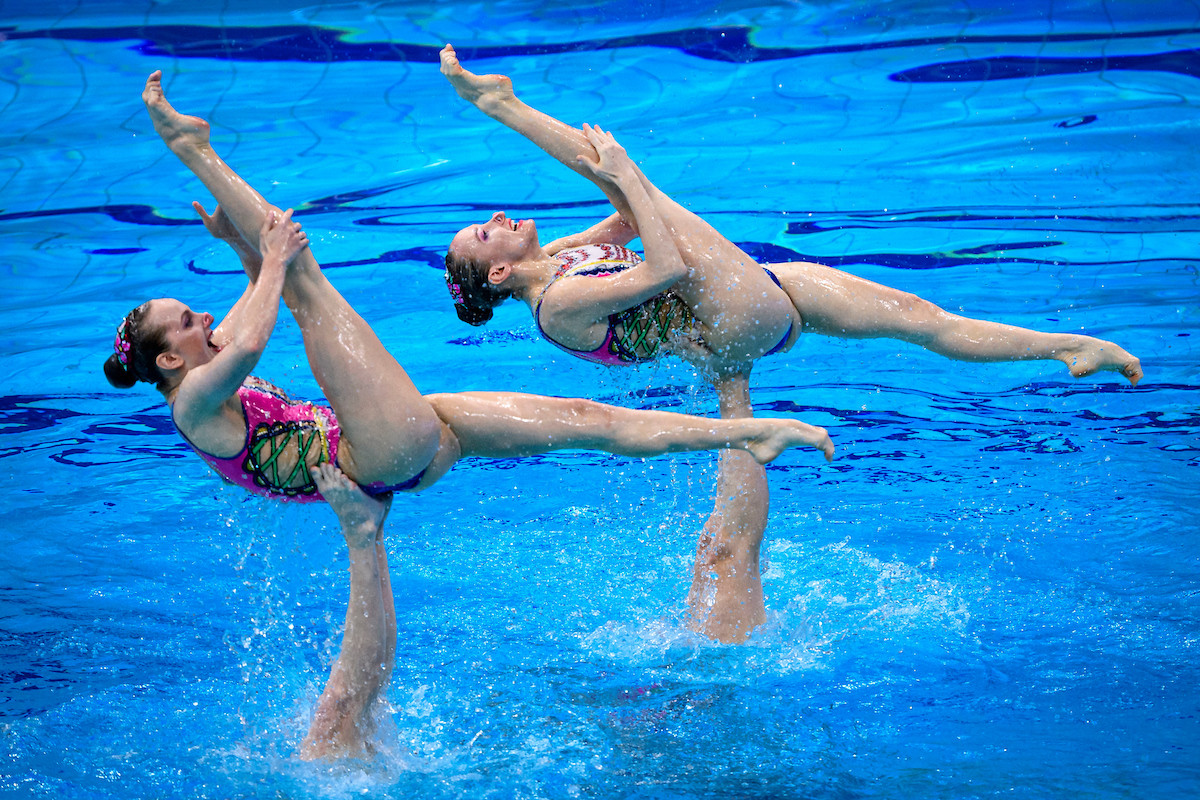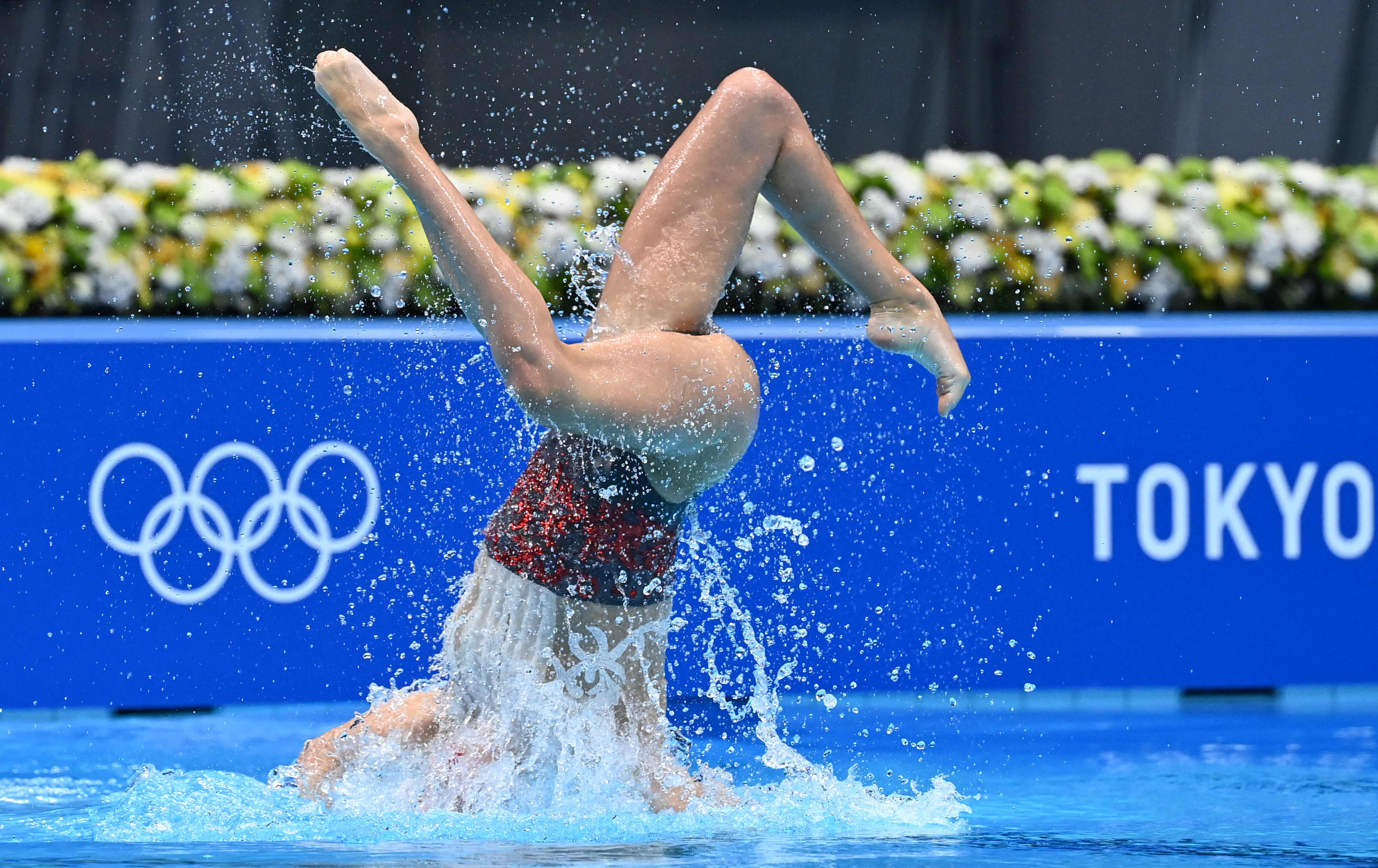Olympics viewers may have noticed that synchronized swimming goes by another name these days: artistic swimming. The moniker made its Olympic debut at the 2020 Tokyo Games in 2021, nearly 40 years after the sport itself entered the Olympics.
According to The Atlantic, the idea for a rebrand originated with the International Olympic Committee (IOC), which hoped that it would help the sport’s visibility and popularity. The International Swimming Federation, FINA, asked its internal Technical Synchronized Swimming Committee (TSSC) to come up with a new name, and it submitted artistic swimming. Not only would that highlight the sport’s artistic component—which accounts for one-third of the scoring breakdown—but it would also ideally engender associations with artistic gymnastics, one of the most popular, difficult, and respected Olympic events. FINA approved the name in a 2017 vote, and the rest is history.
Or it would be, if the new name (and the way it came to be) wasn’t such a thorny issue within the synchronized swimming community. The TSSC had initially resisted the rebrand, but ultimately relented for the greater good of not falling out of favor with FINA and the IOC—especially since the IOC had said it would keep the sport in the Olympics if it chose a different name. Moreover, FINA usually lets sport-specific subgroups weigh in on matters germane to their sport before having the general congress vote on them. The organization bypassed that step this time, leaving the name change mostly up to delegates from other aquatic sports who had no chance to educate themselves on the issue.
After the vote, former synchronized swimmer Kris Harley-Jesson kickstarted a Change.org petition in protest of the rebrand, explaining in the description that artistic swimming “does nothing to convey the athleticism” of the sport and is only “a lateral move.” But she also articulated that she’s not against rebranding in general—it’s more a problem with this particular title, and the fact that it was chosen without enough input from synchro swimmers. The petition garnered some 11,000 signatures.
Synchronized swimming does have a bit of a branding problem. Contrary to popular belief, synchronized doesn’t refer to the swimmers being synchronized to each other—it means they’re synchronized to music (which takes the contradiction out of solo synchronized swimming). And the highly artistic performance quality of the sport—not to mention its history as an Old Hollywood gimmick—can sometimes distract viewers from its difficulty level. As Artistic Swimming Australia president Kim Davis told NBC Chicago, “Imagine sprinting all-out, while underwater, chlorine in your eyes, holding your breath and trying to be in line with seven of your other colleagues.” The word artistic doesn’t quite capture all that.
The History of Artistic Swimming
It has been a difficult journey over the years for these pretty swimmers. Not only have they battled the danger of holding their breath underwater and endured the weight of the garments they were forced to wear to preserve their modesty, they have had to fight a society that largely assumed that women just didn’t swim.
They were allowed into the water for mineral bathing, which was considered acceptable as long as they wore large gowns and entered from a bathing machine that was pulled to the water’s edge by a horse. Even then, men would gather at a distance to watch them through telescopes in what they called ‘naiad hunting’. Of course, these peeping toms weren’t the ones who were criticised. Valosik quotes one 19th-century London newspaper blaming women for failing to ‘confine their water frolics to the bath under the awning, but boldly wander away and so expose themselves to the vulgar throng’.
The Male Gaze
The male gaze is a constant theme of the book. In the 1920s, when women first became lifeguards, they found themselves rescuing men who revived remarkably quickly – as in the case of the American swimmer Ruth MacNeely, who was the first female guard on the Jersey Shore. One day the scene repeated itself so often that it became apparent to the manager that the men just wanted to be rescued by the young woman. If any man was in trouble after that he was on his own, because the beach manager ordered MacNeely to assist only women and children.
In the second world war, swimmers performed for wounded soldiers, and Virginia Hunt Newman was surprised to see many of them leaving the stands as she was diving. ‘She later found out they had gone to the pool’s subterranean level to watch through the underwater windows, hoping to catch a glimpse as Newman adjusted her top after each dive.’ She concluded both that the men weren’t ‘as sick or wounded as they would have you believe’ and that ‘it made you feel really part of the war effort’.
Swimming was extremely important in the war: soldiers needed to be proficient in case they ended up in the sea; and training to move quickly through water that might be filled with debris, or swim with just one arm, clutching a rifle in the other, involved learning synchronized swimming. Indeed, it was men who moved swimming on from being something people did either as a performance or to save lives to being a competitive sport. Top athletes now train for up to 14 hours a day; but there is still a fine line between artistry and athleticism, with complaints about nose clips obscuring the ‘beauty’ of competitors. Valosik, a synchronized swimmer herself, horrified her teammates when she insisted on wearing goggles at her first meet. ‘You can’t make eye contact with the judges while wearing goggles,’ one pointed out to her. ‘It just isn’t done.’
Artistic Swimming Today
The sport changed its name from synchronized swimming to artistic swimming in 2017 to give it a broader appeal. But some of the participants haven’t fully embraced the change and still call it “synchro.”
Men were allowed to compete in the sport for the first time at these Olympics, but none were selected for a team. A mixed duet team event could be added for Los Angeles in 2028 to give men a bigger chance to participate.
The Future of Artistic Swimming
Despite the name change, artistic swimming continues to evolve. The sport now includes elements of acrobatics, underwater ballet, and even synchronized diving. And while the traditional focus on synchronized movements remains central to the sport, the addition of artistic expression and creative choreography has made the sport even more dynamic and captivating. It's a testament to the sport's enduring appeal and its continued commitment to pushing boundaries and captivating audiences.
So What's The Verdict on Artistic Swimming?
It's a sport that has come a long way. And it's a sport that deserves a lot more recognition. So next time you're watching the Olympics, take a moment to appreciate the artistry and athleticism of the artistic swimmers. It's a truly amazing sport that deserves to be celebrated.


















